
The Civilian Conservation Corps (CCC) was a voluntary government work relief program that ran from 1933 to 1942 in the United States for unemployed, unmarried men ages 18–25 and eventually expanded to ages 17–28. The CCC was a major part of President Franklin D. Roosevelt's New Deal that supplied manual labor jobs related to the conservation and development of natural resources in rural lands owned by federal, state, and local governments. The CCC was designed to supply jobs for young men and to relieve families who had difficulty finding jobs during the Great Depression in the United States. There was eventually a smaller counterpart program for unemployed women called the She-She-She Camps, which were championed by Eleanor Roosevelt.

The North Shore consists of many affluent suburbs north of Chicago, Illinois, bordering the shores of Lake Michigan. These communities fall within suburban Cook County and Lake County. The North Shore's membership is often a topic of debate, and it includes some Chicago suburbs which do not border Lake Michigan. However, Lake Bluff, Lake Forest, Highwood, Highland Park, Deerfield, Glencoe, Northbrook, Northfield, Winnetka, Kenilworth, Wilmette, Golf, Glenview, Skokie, and Evanston, are generally considered to be the main constituents of the North Shore. The North Shore is known for its affluence, high level of education, proximity to Chicago, and top-rated public schools. Lake County, Illinois is among the wealthiest counties in the U.S. and several of the wealthiest zip codes are there.

Flandrau State Park is a state park of Minnesota, United States, on the Cottonwood River adjacent to the city of New Ulm. Initially called Cottonwood River State Park, it was renamed in 1945 to honor Charles Eugene Flandrau, a leading citizen of early Minnesota who commanded defenses during the Battles of New Ulm in the Dakota War of 1862. The park was originally developed in the 1930s as a job creation project to provide a recreational reservoir. However the dam was repeatedly damaged by floods and was removed in 1995.
McDowell Grove Forest Preserve, located in Naperville, state of Illinois, is a 439-acre (178 ha) preserve on the West Branch of the DuPage River.
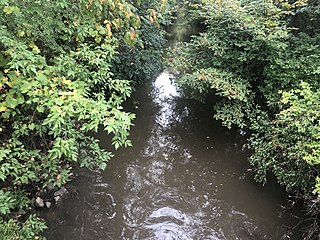
The Skokie River is a 20-mile-long (32 km) river that flows through the northern suburbs of Chicago, Illinois, United States. It flows almost parallel to the shore of Lake Michigan, and historically discharged its outflow into that lake via the Chicago River. However, the construction of the Chicago Sanitary and Ship Canal in 1900 caused the drainage of the Chicago River, including its Skokie River tributary, to flow southwestward towards the Mississippi River.
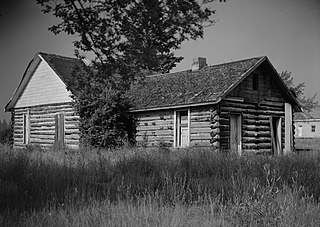
Fort Missoula was established by the United States Army in 1877 on land that is now part of the city of Missoula, Montana, to protect settlers in Western Montana from possible threats from the Native American Indians, such as the Nez Perce.
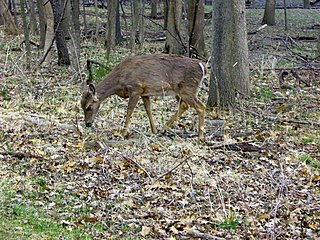
The North Branch Trail is a Class I bicycle trail located in northeastern Cook County, Illinois. The trail starts at the western part of Gompers Park in Chicago, and from there it continues north approximately 22 miles (35 km) to Glencoe. The trail follows a path along the North Branch of the Chicago River, the Skokie River and the Skokie Lagoons.
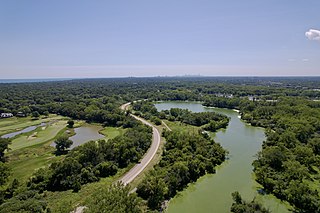
Skokie Lagoons is a nature preserve in Glencoe and Winnetka, Illinois, owned and managed by the Forest Preserve District of Cook County. The park is bordered by Dundee Road to the north, Forestway Drive to the east, Willow Road to the south, and the Edens Expressway to the west. Within the park, there are seven inter-connected lagoons totaling 190 acres (0.77 km2). Water flows southward from the Chicago Botanic Garden through the lagoons to the Skokie River. The overall water level in the lagoons is controlled by the main control dam at Willow Road. Three low dams keep the water levels below the inner islands. Recreational opportunities at Skokie Lagoons include biking, fishing, boating, and birding.

Robert Fechner was a national labor union leader and director of the Civilian Conservation Corps (1933–39), which played a central role in the development of state and national parks in the United States.

Camp Tulelake was a federal work facility and War Relocation Authority isolation center located in Siskiyou County, five miles west of Tulelake, California. It was established by the United States government in 1935 during the Great Depression for vocational training and work relief for young men, in a program known as the Civilian Conservation Corps. The camp was established initially for CCC enrollees to work on the Klamath Reclamation Project.

Spencer State Forest is a Massachusetts state forest and recreation reserve located in the town of Spencer, managed by the Massachusetts Department of Conservation and Recreation. The 92 mile (148 km) Midstate Trail passes through the state forest. The Commonwealth of Massachusetts also conducts logging in some parts of the property.

Devil's Den State Park is a 2,500-acre (1,000 ha) Arkansas state park in Washington County, near West Fork, Arkansas in the United States. The park was built by the Civilian Conservation Corps, beginning in 1933. Devil's Den State Park is in the Lee Creek Valley in the Boston Mountains, which are the southwestern part of The Ozarks. The park, with an 8 acres (3.2 ha) CCC-built lake, is open for year-round recreation, with trails for hiking, mountain biking and horseback riding. Devil's Den State Park also has several picnic areas, a swimming pool and cabins, with camping sites ranging from modern to primitive. Fossils of coral and crinoids can be found along the banks and within Lee Creek at Devil's Den State Park.
The McMillan Woods CCC camp was Civilian Conservation Corps camp NP-2 on the Gettysburg Battlefield planned in September 1933 near CCC Camp Renaissance in Pitzer Woods. Captain Francis J. Moran moved from Camp Renaissance to become the new camp NP-2 commander in October 1933 The camp opened a new recreation hall in 1934 and provided manpower for building the veterans camp for the 1938 Gettysburg reunion, and about 50 enrollees of CCC Company #1355-C served as aides for unaccompanied veterans. During the reunion, Company F of the 34th Infantry used the CCC camp and had a headquarters office under Major C. Gilchrist and Capt. E. E. Wright. Captain Frederick L. Slade was the CCC commander on April 1, 1939.

Joseph Hilliard Cain Sr. was an American military officer, a member of the Mississippi State Legislature, a licensed preacher and Mississippi educator.
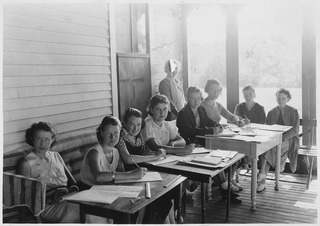
The She-She-She Camps were camps for unemployed women that were organized by Eleanor Roosevelt (ER) in the United States as a counterpart to the Civilian Conservation Corps (CCC) programs designed for unemployed men. ER found that the men-only focus of the CCC program left out young women who were willing to work in conservation and forestry and to sign up for the six-month programs living away from family and close support. She lobbied for a sister organization to the CCC that would be for young women. Eleanor Roosevelt proposed that this would consist of camps for jobless women and residential worker schools. The She-She-She camps were funded by presidential order in 1933. Labor Secretary Frances Perkins championed one such camp after ER held a White House Conference for Unemployed Women on April 30, 1934, and subsequently ER's concept of a nationwide jobless women's camp was achieved. While the public largely supported the New Deal programs and the CCC was a huge success, the women's version barely topped 5,000 women annually by 1936 and overall served 8,500 as a result of ER's support. This compares to more than 3 million men who participated in the CCC.

The Civilian Conservation Corps-Prisoner of War Recreation Hall is a historic building located in Eldora, Iowa, United States. Known as Camp Flying Goose, the Civilian Conservation Corps' (CCC) Company 1755 made Eldora their home base in 1933. They constructed this building that year for their use as a barracks while they worked on projects in the area, which included building Upper Pine Lake in Pine Lake State Park. CCC Company 1752, the Erosioners, replaced them two years later, and they built many of the facilities in the park. With the start of World War II, the CCC left the camp. The National Youth Association used the camp from 1940 to 1942.
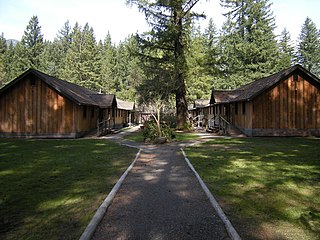
Camp North Bend, also known as Camp Waskowitz, is a 9+1⁄2 acre complex of wood-frame buildings. Constructed by and for the Civilian Conservation Corps (CCC) in 1935, it was added to the National Register of Historic Places in 1993. It is the only intact example of CCC work camp design and construction in King County, Washington. The site is now used by the Highline School District for an outdoor school program focused on environmental education.
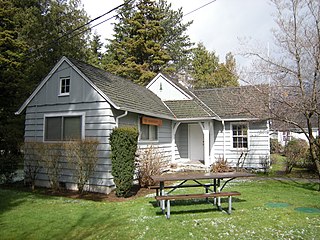
The North Bend Ranger Station is a collection of buildings operated by the USDA Forest Service in the Mount Baker-Snoqualmie National Forest. Constructed by the Civilian Conservation Corps (CCC) in 1936, it was added to the National Register of Historic Places in 1991. The multiple buildings indicate the expansion of Forest Service responsibilities from custodial supervision to extensive resource management. North Bend Ranger Station is considered historic both for its distinctive rustic architecture and for its association with the federal New Deal programs.
Camp Pine was a Civilian Conservation Corps camp in Des Plaines, Illinois, north of Chicago. It was leased by the United States Department of Agriculture during World War II to house civilian farm workers from 1943 to 1944. The camp then housed German prisoners of war from 1945 to 1946. Its site is found in Camp Pine Woods forest preserve.

















